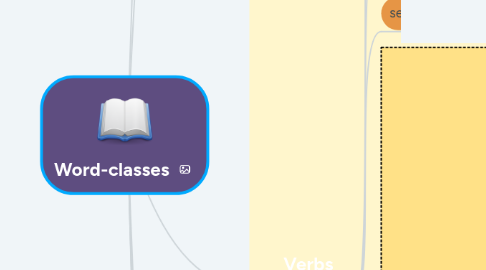
1. Nouns
1.1. common / propper nouns
1.1.1. common nouns
1.1.2. propper nouns
1.2. concrete / abstract nouns
1.2.1. concrete nouns
1.2.2. abstract nouns
1.3. countability
1.3.1. countable nouns
1.3.1.1. number
1.3.1.1.1. singular
1.3.1.1.2. plural
1.3.2. uncountable nouns
1.3.3. both countable and uncountable nouns
1.4. gender
1.4.1. masculine
1.4.2. neutral
1.4.3. feminine
1.5. case
1.5.1. common case
1.5.2. genitive case
1.5.2.1. of / ´s
2. Pronouns
2.1. classification of pronouns
2.1.1. central pronouns
2.1.1.1. personal
2.1.1.2. possessive
2.1.1.3. reflexive
2.1.2. relative pronouns
2.1.3. interogative pronouns
2.1.4. demonstrative pronouns
2.1.5. indefinite pronouns
2.1.5.1. positive
2.1.5.1.1. universal
2.1.5.1.2. assertive
2.1.5.1.3. non-assertive
2.1.5.2. negative
2.2. reference
2.2.1. antecedent
2.2.2. referent
3. Verbs
3.1. structural chracteristics
3.1.1. morphological forms
3.1.1.1. base
3.1.1.2. -s
3.1.1.3. -ing
3.1.1.4. -ed
3.1.2. finitness
3.1.2.1. finite
3.1.2.1.1. base
3.1.2.1.2. -s
3.1.2.1.3. -ed 1
3.1.2.2. non-finite
3.1.2.2.1. -ing
3.1.2.2.2. -ed 2
3.1.2.2.3. bare infinitive
3.1.2.2.4. to infinitve
3.2. syntactic features
3.2.1. intransitive verbs
3.2.1.1. SV
3.2.2. transitive verbs
3.2.2.1. mono-transitive
3.2.2.1.1. SVO
3.2.2.2. di-transitive
3.2.2.2.1. SVOiOd
3.2.2.3. complex transitive
3.2.2.3.1. SVOCo, SVOA
3.2.3. linking (copular verbs)
3.2.3.1. SVCs, SVA
3.3. semantic features
3.3.1. stative
3.3.2. dynamic
3.4. classification of verbs
3.4.1. full verbs = lexical, we determine following aspects:
3.4.1.1. + semantic features
3.4.1.1.1. stative
3.4.1.1.2. dynamic
3.4.1.2. + syntactic features
3.4.1.2.1. intransitive
3.4.1.2.2. transitive
3.4.1.2.3. linking (copular)
3.4.1.3. + finitness
3.4.1.3.1. finite
3.4.1.3.2. non-finite
3.4.1.4. time ?
3.4.1.5. tense
3.4.1.5.1. English tenses
3.4.1.6. aspect
3.4.1.6.1. perfect
3.4.1.6.2. progressive
3.4.1.6.3. other ???
3.4.1.7. mood
3.4.1.7.1. indicative. mood
3.4.1.7.2. imperative mood
3.4.1.7.3. interrogative mood
3.4.1.7.4. subjunctive mood
3.4.1.7.5. conditional mood
3.4.1.8. voice
3.4.1.8.1. active voice
3.4.1.8.2. passive voice
3.4.2. auxiliary (modal) verbs
3.4.2.1. central auxiliary
3.4.2.2. marginal auxiliary
3.4.2.3. semi-auxiliary
3.4.2.4. modal idioms
3.4.3. primary verbs
3.4.3.1. DO, HAVE, BE
3.4.3.1.1. functioning as auxiliary (modal)
3.4.3.1.2. functioning as full
3.4.4. phrasal verbs
4. Adjectives
4.1. inherent / non-inherent
4.1.1. inherent
4.1.2. non-inherent
4.2. gradable / non-gradable
4.2.1. gradable
4.2.2. non-gradable
4.3. central / peripheral / postpositive
4.3.1. central
4.3.1.1. attributive position + predicative position
4.3.2. peripheral
4.3.2.1. attributive position only
4.3.3. postpositive
4.3.3.1. after the noun
4.4. stative / dynamic
4.4.1. stative
4.4.2. dynamic
